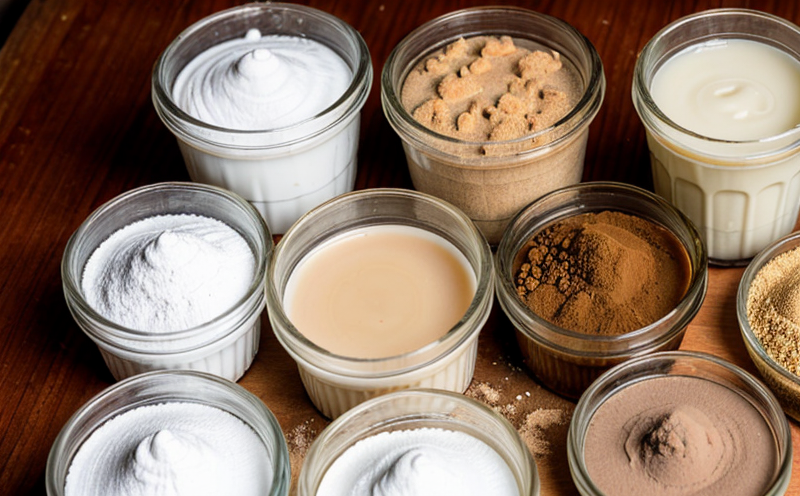ASTM E2874 Mold Detection in Food Packaging Materials
The ASTM E2874 standard provides a comprehensive methodology for detecting mold growth on food packaging materials. This service is critical for ensuring that the integrity and safety of packaged foods are maintained throughout their shelf life, thereby protecting consumers from potential health hazards associated with mycotoxins and other harmful mold byproducts.
The ASTM E2874 protocol specifies a series of steps to be followed in order to accurately detect mold contamination. These include the selection of appropriate sampling points, proper handling and preparation of samples, and the use of suitable detection methods. The standard also provides guidance on interpreting results and taking corrective actions if necessary.
The testing process begins with the collection of samples from various points within a packaging facility. This ensures that all potential areas of contamination are covered. Samples must then be prepared according to specified procedures, which may involve dilution or other treatments designed to enhance detection sensitivity. Once prepared, these samples undergo analysis using advanced microscopy techniques such as scanning electron microscopy (SEM) and confocal laser scanning microscopy (CLSM).
These instruments allow for high-resolution imaging of mold colonies on packaging surfaces, enabling precise identification of different species of molds present. Additionally, quantitative analyses can be performed to determine the extent of contamination.
The results from such tests are essential for quality assurance teams who rely on them to make decisions about product safety and shelf-life extension strategies. They also serve as important input data during regulatory compliance assessments conducted by government agencies like FDA or EU authorities.
For R&D engineers involved in developing new packaging materials, this service offers valuable insights into how changes in formulation could impact mold resistance properties of the material. It helps them optimize formulations to ensure longer-lasting protection against microbial growth without compromising on performance characteristics such as barrier functionality or mechanical strength.
In summary, adherence to ASTM E2874 ensures not only compliance with international standards but also enhances overall product quality by providing robust evidence regarding the presence of mold spores in packaging substrates. This information can be used strategically to improve production processes and ultimately contribute towards enhancing consumer trust in food safety measures implemented across supply chains.
Industry Applications
- Packaging Manufacturers: Ensuring that new materials meet the mold resistance requirements set out by regulatory bodies.
- R&D Engineers: Optimizing formulations for improved mold resistance properties in packaging substrates.
- Quality Assurance Teams: Monitoring production processes to ensure compliance with international standards and maintaining high levels of product quality.
- Safety Officers: Assessing potential risks associated with mold contamination within facilities and implementing preventive measures where needed.
Customer Impact and Satisfaction
Implementing ASTM E2874 mold detection in food packaging materials significantly enhances customer satisfaction by ensuring that packaged goods remain safe for consumption over their intended shelf life. By detecting early signs of mold contamination, our clients can take prompt corrective actions such as adjusting environmental controls within their facilities or reformulating packaging materials to enhance mold resistance.
This proactive approach not only prevents recalls but also avoids costly disruptions in production schedules. Moreover, it demonstrates a commitment to maintaining high standards of hygiene and safety, which is increasingly important for consumers who are more informed about foodborne illnesses and their causes.
Our clients report higher levels of customer confidence and loyalty when they can point to rigorous testing protocols like ASTM E2874 as part of their quality assurance processes. This contributes positively to brand reputation and market share, making it an invaluable service for any company operating in the food industry or related sectors.
International Acceptance and Recognition
The ASTM E2874 standard has gained widespread acceptance among governments, regulatory bodies, and industry stakeholders worldwide. Its rigorous methodology aligns with international best practices for assessing mold contamination in food packaging materials.
Governments such as those operating under the European Union framework or the United States Department of Agriculture (USDA) recognize ASTM E2874 as a valid reference document when evaluating compliance with local regulations. This recognition ensures that companies adhering to this standard enjoy smoother operations across borders, reducing administrative burdens associated with multiple compliance requirements.
Regulatory bodies like the FDA in the US or the European Medicines Agency (EMA) often cite ASTM E2874 as a benchmark for mold detection methods. This not only enhances credibility but also facilitates easier access to markets where these standards are enforced.





